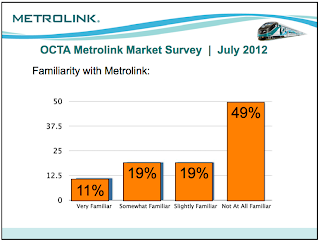The problem, as with many rail patronage issues, is one of knowledge. The most frequent refrain that rail advocates hear when talking with friends, coworkers, or the normal person in the street isn't that the train doesn't work for them, but rather "There's a train?" With such significant differences between user and non-user perception, the primary focus of Metrolink, and Amtrak as well, has to be on simply bringing the existence of the train as well as its reliability as a means of transportation to the knowledge of the common commuter. People will not take what they do not know to exist or reliably work.
Today I was reading the agenda for the March 8th Metrolink Board of Director's meeting and came across a pair of interesting graphs in a presentation about rebranding Metrolink.
Since much of the presentation was about how Metrolink is often confused with Los Angeles Metro, the apparent contradiction with the familiarity against named in Orange County should be easily resolved.
This, quite frankly, is a completely and utterly pathetic showing for potential customer awareness of Metrolink and Amtrak. For crying out loud, the Pacific Surfliner is the busiest American rail corridor, both in terms of train frequency and passengers carried, outside of the Northeast, with nearly 60% of passenger trips going to or from Orange County, and this is from a knowledgable population base of only 300,000? There are more than 10,000 daily Metrolink riders between the Orange County, 91, and IE-OC lines, and these from a knowledgable population base of only 600,000 persons, or perhaps 900,000 if we count all who consider themselves very or somewhat familiar with Metrolink.
To a certain degree this is a self-selecting ridership base; those who are motivated enough by transit to seek it out will of course be more knowledgable and aware of it and a linear extrapolation of ridership potential with expanded awareness would not be in any way accurate. But at the same time, the potential is clear. This also has the potential to become a self-sustaining public relations campaign. Consider, for instance, the fact that the Orange County Line has a 74% revenue recovery rate (page 33). Additional ridership thanks to a successful media campaign to raise awareness of the line easily has the potential to raise the line into a revenue-neutral or even revenue-positive state, at which point even the libertarian local paper, the Orange County Register, can be used to drum up additional support and awareness as they crow about their financial success, with the additional bonus that media articles are at no expense to the agency.
Unsurprisingly, the marketing budgets of Metrolink and Amtrak are tiny. For the Surfliner, approximately $1 million per year. For Metrolink, the FY2012-2013 budget contains $1,257,000 for marketing. This amounts to about 1% of the total budget for the Surfliner and 0.6% of the total budget for Metrolink. These numbers are far too low, as the pathetic potential customer awareness shows. An increase to five million dollars a year by each agency is not a budget breaker for either of them. If there should be worries about the rate of return on the increased spending, then perhaps they should consider asking local cities, chambers of commerce, and businesses to help underwrite the campaign in exchange for focus on those cities and businesses in advertising. There is absolutely no reason why an advertising campaign shouldn't kill two birds with a single stone after all.


I partially disagree. Advertising only helps if you have a great product to pitch. Metrolink needs to first provide more frequent trains between OC and LA Union Station; 30 minutes all day from 6 am to 9 pm, and every 15 min at rush hour. Then, they will have a product that is memorable and reliable, and it would be worth spending some extra money on advertising, with simple messages like "Trains from Irvine to LA every 15 minutes" .
ReplyDeleteThe next step would be electrification, to speed up trips and allow more intermediate stops to be added, or at least faster and lighter non-FRA compliant diesel trains.
Certainly it helps to have a great product to pitch, but it is by no means a necessity. HeadOn is perhaps a perfect example of advertising working despite not having a great product (or even a great commercial). Consider that there is a dual problem here, however. Low awareness doesn't mean just low ridership; it also means that there is going to be a low level of support for spending the money to improve the service with additional frequencies and electrification.
Delete95% on time performance within five minutes. No need to pay for parking. Free wifi. No traffic hassles.
DeleteDoesn't matter whether it's hourly- there are more important factors than headway.
At the moment, the Pacific Surfliner doesn't really want to advertise too much, because if it gets too many more riders, (a) the trains will fill up, and (b) they don't have any more cars to add. So there's a lot to be said for starting the marketing campaign as the new railcars arrive.
ReplyDeleteI'm not sure about Metrolink -- I get the impression they have more spare rolling stock and lower loads, so perhaps marketing would be more helpful there. The name confusion with Metro means that perhaps they do need a new name.
The Surfliner is hardly in any danger of filling up; the occupancy factor is only 31%. Two or three of the peak weekend travel trains have heavy loads, but otherwise it is fairly light. And of course, that's a danger easily remedied by simply raising fares, which has the added bonus of reducing the necessary subsidies to run the train.
DeleteAlso, as far as I'm aware, the Surfliner will not be extended with the new cars; they will serve only to get rid of the Amfleet train set and the leased Superliners.